Tomatoes are a gardener’s favorite and can grow up to 6 feet in height. But that six feet can leave a lot of room for pests and diseases to thrive.
Companion planting can help improve tomato growth and yield by repelling pests or attracting pollinators from other companion plants nearby.
Some great common tomato companion plants include basil, borage, chives, clover, comfrey, dill weed, marigolds, and nasturtiums.
Adding tomato companion plants into your tomato garden can improve your tomato growth and yield while attracting pollinators and repelling negative pests.
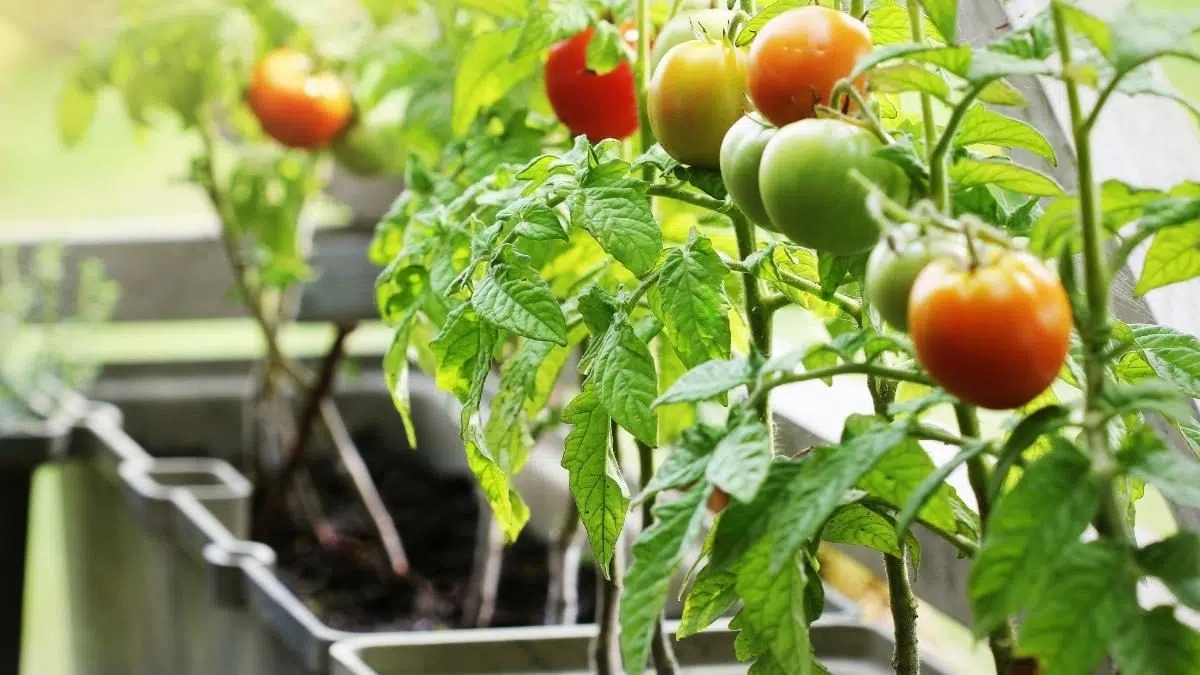
The Best Tomato Companion Plants
Here are some great options for tomato companion planting that I’ve found. I put more information below about pests and common diseases to look out for as well.
1. Basil
Basil is one of the best companions for tomatoes, as they really benefit one another. The basil helps to drastically improve the flavor of your tomatoes, and tomatoes help keep bad bugs away from the basil plants.
It’s a match made in garden heaven.
2. Bee Balm
Bee balm can help improve the flavor of tomatoes and attracts a ton of pollinators that can help make sure your tomato flowers are getting the attention they need.
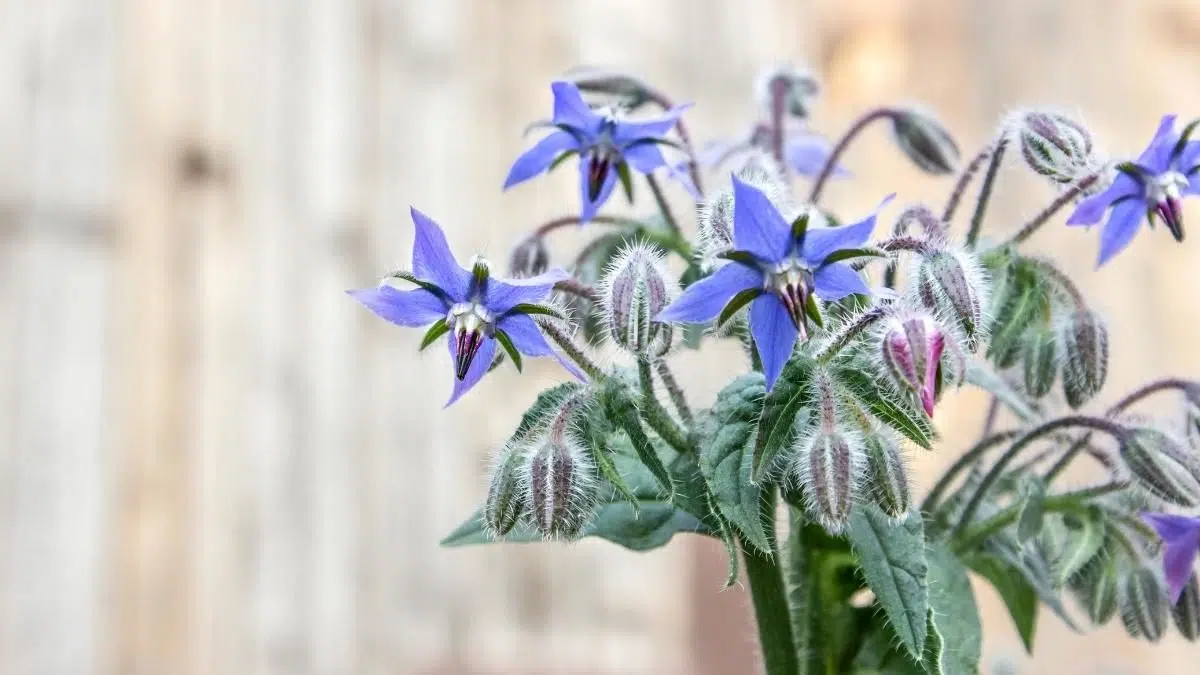
3. Borage
Borage is a great companion for a lot of plants as they attract beneficial insects, and bees, and keeps some of the destructive bugs away.
4. Chives
A member of the allium family, chives do well near tomatoes. They attract hoverflies which can help people your aphid population down almost as well as ladybugs.
5. Cilantro
The flowers of cilantro are what you’re after here. They attract predatory insects that eat the bad bugs that will destroy your tomatoes.
6. Clover
Repel spider mites; brings a ton of pollinators to the plants.
7. Comfrey
Improves tomato root structure; promotes plant growth
8. Dill
Attracts pollinators; repels tomato worms and nematodes.
Companion plants in the Parsley family (Apiaceae) like cilantro, dill, and fennel are great for attracting predatory insects to your garden that feed on pesky aphids.
9. Garlic
Garlic helps create better-tasting tomatoes, AND they’re a good pair in the kitchen as well.
10. Marigolds
Marigolds have been used for centuries as natural pest repellants. They seem to do an amazing job at keeping aphids, whiteflies, and even deer away from gardens.
They’re easy to grow, and the bright flowers are beautiful. They also protect against tomato worms, which makes planting marigolds and tomatoes together a no-brainer!

11. Mint
Mint keeps the aphids at bay, so plant tomatoes near your mint and basil. Just keep in mind that mint plants grow like weeds, so they can easily take over other plants.
12. Nasturtiums
They also help repel hornworms, and attractor pollinators so they’re definitely one you should keep in mind while planting your garden.
13. Petunias
Petunias are a great companion plant for tomatoes because they keep asparagus beetles, leafhoppers, aphids, and tomato worms at bay.
14. Radish
Radishes help keep flea beetles away but you’ll need to plant them very close.
15. Sweet Potatoes
Great for helping reduce diseases that tomatoes are susceptible to.
Most of the diseases that tomatoes are impacted by are caused by water and dirt splashing back up from the ground when it rains or the plants get watered. The leaves of the sweet potatoes can help protect them against this if you plant them close together.
16. Thyme
Thyme is naturally a great repellent for hornworms, and if you’ve ever grown tomatoes before you’ll know what a great relief that is!
What NOT to Plant Near Tomatoes
While there are quite a few good options to plant near tomatoes, there are some you should never plant near your tomatoes.
Here is a full list of what NOT to plant near tomatoes, but these are some of the main ones:
Cabbage
Limits the growth potential of both plants as they are heavy feeders.
Fennel
Fennel will actually inhibit growth in tomatoes, bush beans, and kohlrabi.
Broccoli
Planting broccoli with tomatoes will limit the growth of both plants, leaving you with mediocre broccoli and unproductive tomato plants.
6 Common Problems Pests That Impact Tomato Plants
Companion planting is a great way to organically save yourself some headaches in the garden, but what are we trying to keep away from our tomatoes? Good companion plants help each other, so knowing what you should be keeping an eye out for can be helpful as well.
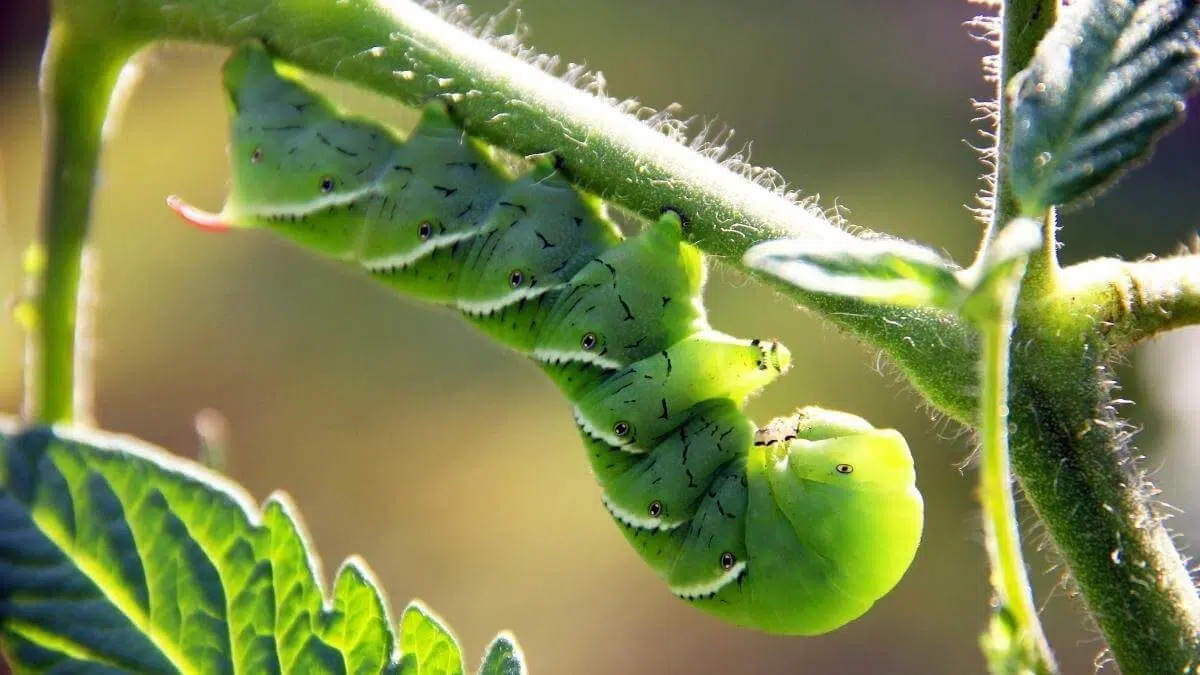
1. Tomato Hornworms
These green, juicy things are disgusting. I dread the days I have to pull some off my plants. Don’t get me wrong, I love gardening but some bugs still creep me out. The tomato hornworm is a moth larva that feeds on tomato plants and tomato leaves. They can grow up to 4 inches long, have five “horn” over each eye, and purple spots on their hind sections.
If tomato worms are present, look for tomato plant leaves with holes in the middle of them. Small clusters of eggs will also be laid on tomato plants.
If tomato worms are a concern, plant marigolds around tomato plants to repel tomato hornworms.
2. Aphids
Ahh, the glitter of the garden. They move in quickly, end up EVERYWHERE, and getting rid of aphids isn’t the easiest task in the world.
These little suckers are small, soft-bodied insects that can be green, black, or red in color. They infest tomato plants and tomato fruits, cause leaves to curl under, and leave a sticky residue on tomato fruits.
Aphids can travel from plant to plant through the wind, but companion planting can help keep them under control.
If aphids have been a problem in the past, try planting petunias nearby.
3. Cutworms
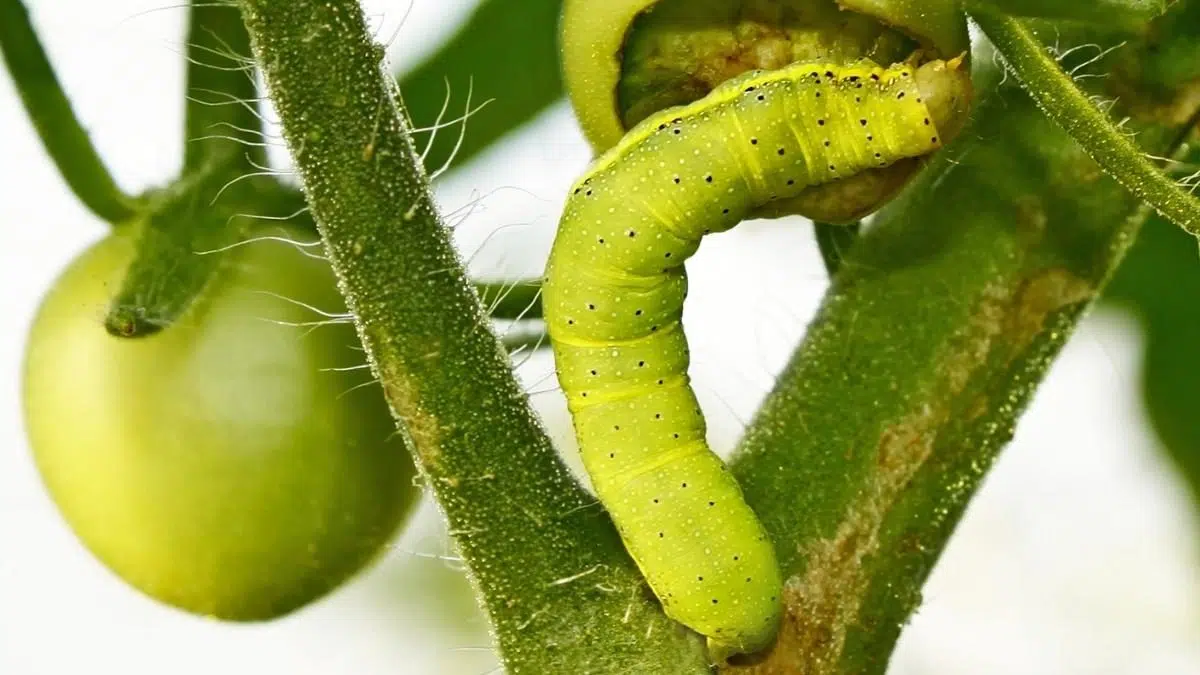
4. Leaf Hoppers
5. Nematodes
Root-knot nematodes can cause yellowing of the leaves and stunted growth of your plants. Crop rotation is one of the best ways to prevent this damage from happening, but many gardeners will also plant marigolds nearby (within 6-8 inches) of your tomato plant to help repel them.
6. Whiteflies
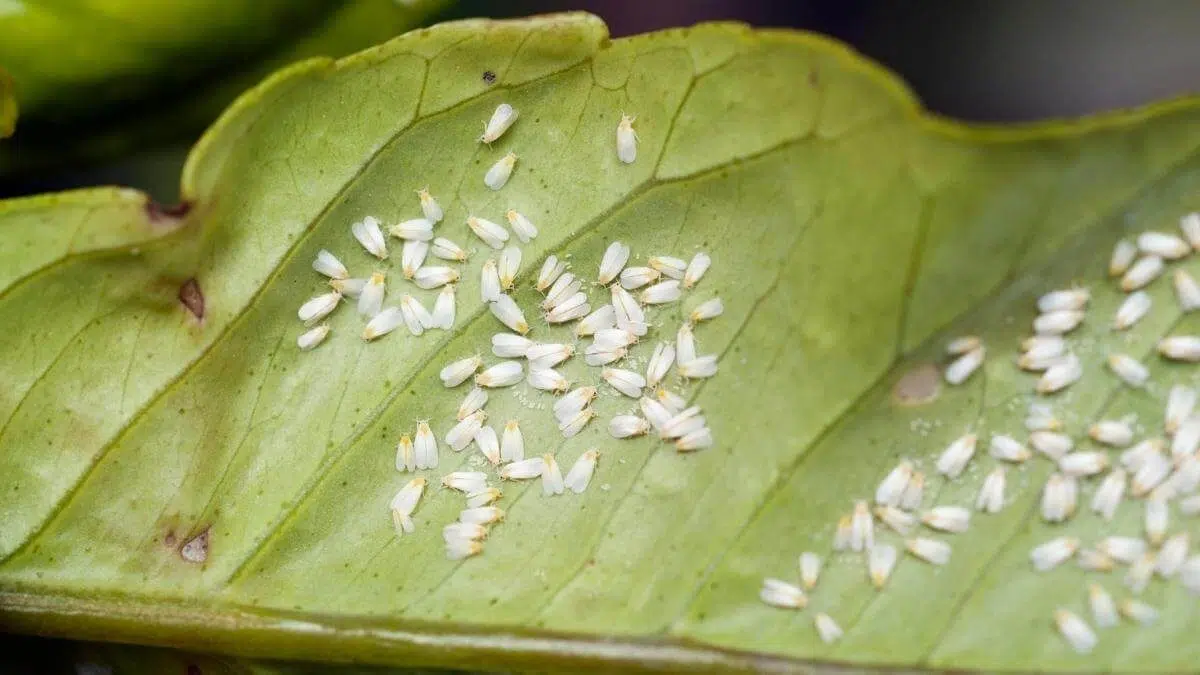
What is Companion Planting?
Companion planting is basically planting certain plants together to improve the growth of one or both.
Companion planting can help deter pests while attracting beneficial insects and pollinators into the mix. Tomatoes need a lot of pollinators to get those flower buds turning into fruit!
Next time you’re planning your garden, see if you can add any of these options to your garden!
What Are the Benefits of Companion Planting?
Companion planting is about putting together plants that will either help or not hurt each other. Some are believed to ward off pests, vermin, and diseases.
It is said that if you plant certain plants together, then the whole becomes greater than the sum of its parts. You can attract helpful predator bugs when you grow marigolds or sunflowers. You can keep aphids away by planting mint. And on, and on.
Attracting Beneficial Insects
The best thing about companion planting is attracting beneficial insects. You want to attract these guys because they’re eating up your bad bugs. Besides, they are also pollinators. If you have an herb garden or vegetable garden, then surely you know how important bees and butterflies are.
Impacting Flavors
The most obvious example of this is growing tomatoes and basil together. The combination of the two just makes your tomatoes taste INCREDIBLE.
Organic Pest Control
Growing your tomatoes near specific herbs and plants will give the tomato a boost of natural pest repellant.
Companion planting is a great way to help increase the health of your tomato plants and get a bigger yield.
Tomatoes & Other Nightshades Have Similar Companions
Other plants in the nightshade family benefit from similar companions as well. Things like peppers, eggplants, and more do well near many of these too. Just be careful to not be planting tomatoes and other nightshades super close to one another as they are typically heavy feeders and will suck up a lot of the nutrients in the soil.
It’s also important to keep in mind that tomatoes, especially indeterminate tomatoes, are tall plants and can get up to 6 feet (or more!) tall. If the companion you’re putting nearby won’t get very big and needs full sun, that could be an issue and stunt the growth of the smaller plant.



Hey Kiddo, Just a Thank you for taking the time to teach us simple facts that were lost to time. Thanx